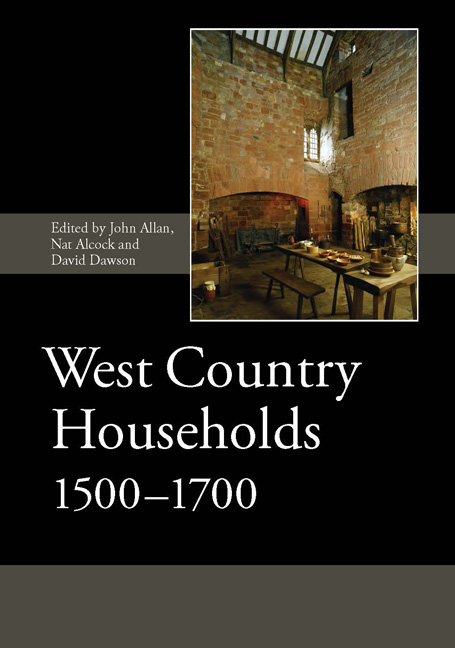Book contents
- Frontmatter
- Dedication
- Contents
- List of Illustrations
- List of Contributors
- List of Abbreviations
- Introduction
- I The Form and Development of West Country Houses
- II The Decoration of West Country Houses
- III The Material Culture of West Country Households
- 10 Culinary Artefacts in West Country Households, 1550–1700: Form, Function and Nomenclature
- 11 The Archaeology of the West Country Bronze Foundries
- 12 Cast Bronze Cooking Pots in England, 1500–1720
- 13 Table Glass in the West Country Home, c. 1500–1700
- 14 Portuguese Faience in South-West England
- 15 Dinner on the Ceiling: the 17th-Century Plasterwork at 144 Fore Street, Exeter
- 16 Pots and Texts: Understanding Pots in Use
- 17 Presenting an Elizabethan Interior: the Reinterpretation of St Nicholas Priory, Exeter
- Index of People and Places
- Index of Subjects
12 - Cast Bronze Cooking Pots in England, 1500–1720
from III - The Material Culture of West Country Households
Published online by Cambridge University Press: 05 May 2015
- Frontmatter
- Dedication
- Contents
- List of Illustrations
- List of Contributors
- List of Abbreviations
- Introduction
- I The Form and Development of West Country Houses
- II The Decoration of West Country Houses
- III The Material Culture of West Country Households
- 10 Culinary Artefacts in West Country Households, 1550–1700: Form, Function and Nomenclature
- 11 The Archaeology of the West Country Bronze Foundries
- 12 Cast Bronze Cooking Pots in England, 1500–1720
- 13 Table Glass in the West Country Home, c. 1500–1700
- 14 Portuguese Faience in South-West England
- 15 Dinner on the Ceiling: the 17th-Century Plasterwork at 144 Fore Street, Exeter
- 16 Pots and Texts: Understanding Pots in Use
- 17 Presenting an Elizabethan Interior: the Reinterpretation of St Nicholas Priory, Exeter
- Index of People and Places
- Index of Subjects
Summary
This paper explores the way in which cast metal cooking vessels, while remaining conservative in function and general form during the period of interest, nevertheless changed in ways that reflect important social changes in late medieval and early post-medieval periods. The vessels that illustrate this paper come from the Butler Collection, now housed in the Somerset County Museum at Taunton.
The cast bronze cooking pots made in England in the period c. 1500–1720 are of three main types. First, the cauldron – a three-legged vessel with lug handles that could be either suspended above the hearth or stood in the embers (Fig. 12.1). Cauldrons varied considerably in size from capacities of less than a gallon up to monsters with capacities between 30 and 60 gallons (136–272li). Of the cauldrons in the Butler collection, about 40 in number, two-thirds have capacities between 1.5 gal and 7.5 gal (6.8–34li). Mould fragments from foundries excavated at Exeter and York relate to the casting of vessels of similar size, with the most common dimensions indicating vessels with a capacity of around two gallons [9.1li]. A 2-gallon cauldron – the size of a modern preserving pan – appears to have been a fairly standard vessel for a small household. Such three-legged pots, albeit of cast-iron, were still in use in the mid-19th century, when Soyer referred to them specifically in his Shilling Cookery for the People and published recipes for a pot of 2 gallons capacity.
Second, the posnet – essentially a small cauldron with a horizontal handle like a modern saucepan, but with three legs, designed specifically to stand on the hearth among the embers (Fig. 12.2). The two posnets in the Butler collection have capacities of 3.5 and 9 pints (2–5.1li) – approximately equivalent to those of modern saucepans.
Third, the skillet is clearly recognizable as the direct forerunner of the modern saucepan, but like the cauldron and posnet is supported on three legs to allow it to stand on the hearth (Fig. 12.3). By 1600 the skillet had largely superseded the posnet as the preferred small to medium-sized cooking vessel.
- Type
- Chapter
- Information
- West Country Households, 1500–1700 , pp. 309 - 320Publisher: Boydell & BrewerPrint publication year: 2015



